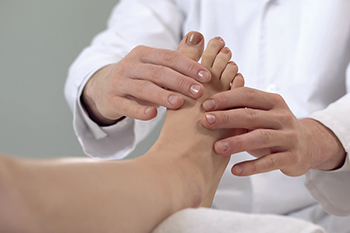Items filtered by date: September 2022
Foot Ulcers and Diabetic Patients

A common foot condition among diabetic patients is a foot ulcer. Foot ulcers often occur from the inability to feel existing cuts, bruises, or scrapes which can be a result of neuropathy. Therefore, it is imperative to check the soles daily. Additionally, engaging in a gentle exercise routine may be beneficial in increasing circulation to the feet. A diabetic foot ulcer generally requires immediate medical care, and this may help to prevent an impending infection that could ultimately lead to amputation when left untreated. A diabetic foot ulcer can cause severe pain and discomfort, and it is suggested to refrain from putting any weight on the affected foot. Some people choose to wear shoes that are designed specifically for diabetic patients as well as compression wraps that help to improve circulation. If you have diabetes, it is strongly suggested that you are under the care of a podiatrist who can effectively treat and help you to manage this condition.
Diabetic foot care is important in preventing foot ailments such as ulcers. If you are suffering from diabetes or have any other concerns about your feet, contact Dr. Mark Gagnon from Advanced Podiatry. Our doctor can provide the care you need to keep you pain-free and on your feet.
Diabetic Foot Care
Diabetes affects millions of people every year. The condition can damage blood vessels in many parts of the body, especially the feet. Because of this, taking care of your feet is essential if you have diabetes, and having a podiatrist help monitor your foot health is highly recommended.
The Importance of Caring for Your Feet
- Routinely inspect your feet for bruises or sores.
- Wear socks that fit your feet comfortably.
- Wear comfortable shoes that provide adequate support.
Patients with diabetes should have their doctor monitor their blood levels, as blood sugar levels play such a huge role in diabetic care. Monitoring these levels on a regular basis is highly advised.
It is always best to inform your healthcare professional of any concerns you may have regarding your feet, especially for diabetic patients. Early treatment and routine foot examinations are keys to maintaining proper health, especially because severe complications can arise if proper treatment is not applied.
If you have any questions please feel free to contact one of our offices located in Crestwood, Orland Park, and Summit, IL . We offer the newest diagnostic and treatment technologies for all your foot and ankle needs.
What Can Cause Tarsal Tunnel Syndrome?

There is a nerve that stretches from the back of the leg to the inner ankle, and this is known as the tibial nerve. When this becomes pinched as a result of an injury, it may lead to tarsal tunnel syndrome. Additionally, this condition may occur in people who have flat feet or who have an existing tissue mass or cyst. It is helpful to rest the affected foot as often as possible as this may reduce some of the associated swelling. In severe cases, anti-inflammatory medications may be prescribed, and it can be beneficial to wear custom-made orthotics. Numbness and a tingling sensation are symptoms that people can experience when they have this condition, and it can be quite uncomfortable. If you are afflicted with tarsal tunnel syndrome, it is strongly urged that you consult with a podiatrist who can effectively determine the cause, as well as implement the correct treatment methods.
Tarsal tunnel syndrome can be very uncomfortable to live with. If you are experiencing tarsal tunnel syndrome, contact Dr. Mark Gagnon of Advanced Podiatry. Our doctor can provide the care you need to keep you pain-free and on your feet.
Tarsal Tunnel Syndrome
Tarsal tunnel syndrome, which can also be called tibial nerve dysfunction, is an uncommon condition of misfiring peripheral nerves in the foot. The tibial nerve is the peripheral nerve in the leg responsible for sensation and movement of the foot and calf muscles. In tarsal tunnel syndrome, the tibial nerve is damaged, causing problems with movement and feeling in the foot of the affected leg.
Common Cause of Tarsal Tunnel Syndrome
- Involves pressure or an injury, direct pressure on the tibial nerve for an extended period of time, sometimes caused by other body structures close by or near the knee.
- Diseases that damage nerves, including diabetes, may cause tarsal tunnel syndrome.
- At times, tarsal tunnel syndrome can appear without an obvious cause in some cases.
The Effects of Tarsal Tunnel Syndrome
- Different sensations, an afflicted person may experience pain, tingling, burning or other unusual sensations in the foot of the affected leg.
- The foot muscles, toes and ankle become weaker, and curling your toes or flexing your foot can become difficult.
- If condition worsens, infections and ulcers may develop on the foot that is experiencing the syndrome.
A physical exam of the leg can help identify the presence of tarsal tunnel syndrome. Medical tests, such as a nerve biopsy, are also used to diagnose the condition. Patients may receive physical therapy and prescriptive medication. In extreme cases, some may require surgery.
If you have any questions please feel free to contact one of our offices located in Crestwood, Orland Park, and Summit, IL . We offer the newest diagnostic and treatment technologies for all your foot and ankle needs.
Common Symptoms of Sesamoiditis

A foot injury can lead to inflammation and irritation of the sesamoid bones which is known as sesamoiditis. Prompt medical attention is often needed and failure to do so may lead to additional inflammation of the surrounding tendons and ligaments. The pain of this foot condition is often felt in the ball of the foot directly under the joint in the big toe. It can be difficult to walk, and the pain may intensify when the big toe is stretched. Many patients often have a limited range of motion in the big toe, and it may be hard to straighten the toe. Sesamoiditis can occur when the pressure on the ball of the foot is increased, and this may happen from frequently participating in running and jumping activities. Existing foot structures like high arches and bony feet may contribute to sesamoiditis. If you have pain in this part of your foot or exhibit any of the above symptoms, please consult with a podiatrist who can effectively diagnose and treat sesamoiditis.
Sesamoiditis is an unpleasant foot condition characterized by pain in the balls of the feet. If you think you’re struggling with sesamoiditis, contact Dr. Mark Gagnon of Advanced Podiatry. Our doctor will treat your condition thoroughly and effectively.
Sesamoiditis
Sesamoiditis is a condition of the foot that affects the ball of the foot. It is more common in younger people than it is in older people. It can also occur with people who have begun a new exercise program, since their bodies are adjusting to the new physical regimen. Pain may also be caused by the inflammation of tendons surrounding the bones. It is important to seek treatment in its early stages because if you ignore the pain, this condition can lead to more serious problems such as severe irritation and bone fractures.
Causes of Sesamoiditis
- Sudden increase in activity
- Increase in physically strenuous movement without a proper warm up or build up
- Foot structure: those who have smaller, bonier feet or those with a high arch may be more susceptible
Treatment for sesamoiditis is non-invasive and simple. Doctors may recommend a strict rest period where the patient forgoes most physical activity. This will help give the patient time to heal their feet through limited activity. For serious cases, it is best to speak with your doctor to determine a treatment option that will help your specific needs.
If you have any questions please feel free to contact one of our offices located in Crestwood, Orland Park, and Summit, IL . We offer the newest diagnostic and treatment technologies for all your foot and ankle needs.
Who Is a Podiatrist?

Different kinds of doctors specialize in a particular part of the body. For example, otolaryngologists specialize in the ear, nose, and throat, while optometrists specialize in treating the eyes. Podiatrists are doctors that primarily focus on all things related to the feet. Podiatrists must complete a rigorous academic course of study, first obtaining a bachelor’s degree and then earning a degree in Doctor of Podiatric Medicine, referred to as DPM. You might find podiatrists working in a variety of environments. For example, you could find them working in hospitals, private or group practice settings, the armed services, or even in the U.S. Public Health Service. A podiatrist’s work is pertinent because the feet are critical parts of the human body. Not only are feet responsible for movement and balance, but they must also bear the full weight of a human’s body. Since the feet are vulnerable to conditions like plantar fasciitis, plantar warts, athlete’s foot, Morton’s neuroma, and tarsal tunnel syndrome, a podiatrist’s work is essential. If you are interested in taking good care of your feet or you have an existing foot condition, contact a podiatrist.
If you are experiencing pain in the feet or ankles, don’t join the stubborn majority refusing treatment. Feel free to contact Dr. Mark Gagnon from Advanced Podiatry. Our doctor can provide the care you need to keep you pain-free and on your feet.
What Is a Podiatrist?
Someone would seek the care of a podiatrist if they have suffered a foot injury or have common foot ailments such as heal spurs, bunions, arch problems, deformities, ingrown toenails, corns, foot and ankle problems, etc.
Podiatric Treatment
A podiatrist will treat the problematic areas of the feet, ankle or lower leg by prescribing the following:
- Physical therapy
- Drugs
- Orthotic inserts or soles
- Surgery on lower extremity fractures
A common podiatric procedure a podiatrist will use is a scanner or force plate which will allow the podiatrist to know the designs of orthotics. Patients are then told to follow a series of tasks to complete the treatment. The computer will scan the foot a see which areas show weight distribution and pressure points. The podiatrist will read the analysis and then determine which treatment plans are available.
If you have any questions please feel free to contact one of our offices located in Crestwood, Orland Park, and Summit, IL . We offer the newest diagnostic and treatment technologies for all your foot and ankle needs.

